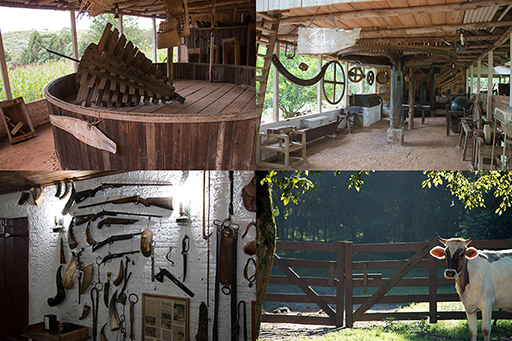
he historical Campos Gerais fazendas are remnants of the old sesmarias, all of which have been diminished over time by successive parcelling of the land by inheritance, sale and gifting. Generally speaking, where they still exist in their old centers, the fazendas keep the names which used to identify them, such as Cambiju, Pitangui, Carambeí, Morungava, Jaguariaíva, Furnas, Fortaleza, Vorá, Boa Vista, Guartelá, Montenegro, Cunhaporanga, Fundão, Caxambu, São João, Lago, Santa Cruz.
Early on, the landowners lived in the towns and delegated authority to a foreman or supervisor.The term “fazendeiro” designated the man responsible for administering the fazenda. All labor in the fields or in animal husbandry was carried out by Black slaves and by “administrated” indigenous people. In the 19th Century, the landowners and their families, most of whom came from São Paulo, Santos, Curitiba, and Paranaguá, began to live on the property. In this period, solid and comfortable mansions were built. Slaves, freed slaves, and household servants lived in dwellings grouped around the owners’ mansions.
For all intents and purposes, the fazenda was an autonomous unit, where nearly everything necessary was produced: food and clothing, construction materials, furniture, tools. Some slaves had specialized roles, and worked as blacksmiths, carpenters, saddlers, tanners, and leatherworkers, all essential in the making of implements and artefacts, as in the spinning and weaving of wool for fabrics and blankets. Most of the workers on the fazenda were dedicated to animal husbandry. These workers were responsible for taming, branding, gelding, maintaining the salt supply, and herding the animals into corrals. At summer’s end, the pastures were burned to hasten the regrowth of vegetation as and provide enough green and tender grass for the animals.
Husbandry was concentrated on bovine animals, but others were raised for use and consumption within the fazenda, such as horses, sheep, and pigs. The breeding of mules, a main business at Socoroba Market, was an activity exclusive to the estâncias (fazendas) of southern Brazil. Morgado de Matheus, the governor of São Paulo State from 1765 to 1775, granted exclusivity in order to encourage the settling of families to guarantee land occupation and the defense of territory from Spanish pretensions.
The fazendas were also charged with supplying animals for food, draught, and riding, to the armies organized to fight in the conflicts along the borders between Portuguese and Spanish possessions.
click on picture
to enlarge